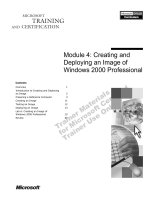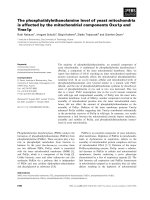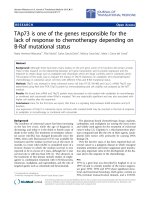Module III Scanning.Scanning - DefinitionScanning is one of the three components of intelligence ppsx
Bạn đang xem bản rút gọn của tài liệu. Xem và tải ngay bản đầy đủ của tài liệu tại đây (16.74 MB, 74 trang )
Scanning
Module III
Scanning - Definition
Scanning is one of the three components of intelligence gathering for an
attacker
The attacker finds information about
the:
attacker
• Specific IP addresses
• Operating Systems
• System architecture
the:
• Services running on each computer
The various types of scanning
fll
are as
f
o
ll
ows:
Port
Scanning
Network
Scanning
Vulnerability
Scanning
Types of Scanning
Port Scanning
A i f b i b k
•
A
ser
i
es o
f
messages sent
b
y someone attempt
i
ng to
b
rea
k
into a computer to learn about the computer’s network
services
• Each associated with a "well-known" port number
Network Scanning
•A
p
rocedure for identif
y
in
g
active hosts on a network
pyg
• Either for the purpose of attacking them or for network
security assessment
Vulnerability Scanning
• The automated process of proactively identifying
vulnerabilities of computing systems present in a network
vulnerabilities of computing systems present in a network
Objectives of Scanning
To detect the live s
y
stems runnin
g
on the network
yg
To discover which
po
rts are active
/
runnin
g
oo po / g
To discover the operating system running on the target system
(fi i i )
(fi
ngerpr
i
nt
i
ng
)
To discover the services running/listening on the target system
To discover the services running/listening on the target system
To disco er the IP address of the target s stem
To disco
v
er the IP address of the target s
y
stem
Checkin
g
for Live S
y
stems
gy
Checking for Live Systems -
ICMP
Scanning
Scanning
In this type of scanning, it is found out which hosts are up in a
net ork b pinging them all
net
w
ork b
y
pinging them all
ICMP scanning can be run parallel so that it can run fast
It can also be helpful to tweek the ping timeout value with the –t
o
p
tion
p
Angry IP Scanner
An IP scanner for Windows
Can scan IPs in an
y
ran
g
e
yg
It simply pings each IP address to check if it is alive
Provides NETBIOS information such as:
• Computer name
•Workgroup name
dd
•MAC a
dd
ress
Angry IP Scanner: Screenshot
Checking for Open Ports
Three Way Handshake
Computer A Computer B
192.168.1.2:2342 syn >192.168.1.3:80
192.168.1.2:2342 < syn/ack 192.168.1.3:80
192.168.1.2:2342 ack >192.168.1.3:80
Connection Established
The Computer A ( 192.168.1.2 ) initiates a connection to the server (
1
9
2.168.1.
3
)
via a
p
acket with onl
y
the SYN fla
g
set
Connection Established
93)p y
g
The server replies with a packet with both the SYN and the ACK flag set
For the final step, the client responds back to the server with a single ACK
packet
If th th t l t d ith t li ti th TCP
If th
ese
th
ree s
t
eps are comp
l
e
t
e
d
w
ith
ou
t
comp
li
ca
ti
on,
th
en a
TCP
connection has been established between the client and the server
Three Way Handshake:
Screenshot
Screenshot
TCP Communication Flags
Standard TCP communications are controlled by flags in
th TCP k t h d
th
e
TCP
pac
k
e
t h
ea
d
er
The fla
g
s are as follows:
• Synchronize – It is also called as "SYN” and is used to
initiate a connection between hosts
•
Acknowledgement
-
It is also called as
"
ACK
”
and is used in
g
•
Acknowledgement
It is also called as ACK and is used in
establishing a connection between hosts
• Push – It is called as "PSH” and instructs receiving system to
send all buffered data immediately
Ut
It i l ll d "URG” d t t th t th d t
•
U
rgen
t
-
It i
s a
l
so ca
ll
e
d
as
"URG”
an
d
s
t
a
t
es
th
a
t th
e
d
a
t
a
contained in the packet should be processed immediately
• Finish – It is also called as "FIN“ and tells remote system that
there will be no more transmissions
• Reset – It is also called "RST” and is used to reset a connection
Nmap
Nmap is a free open source utility for network
li
exp
l
orat
i
on
It is designed to rapidly scan large networks
Features:
It is designed to rapidly scan large networks
• Nmap is used to carry out port scanning, OS detection,
version detection, ping sweep, and many other
thi
Features:
t
ec
h
n
i
ques
• It scans a large number of machines at one time
• It is supported by many operating systems
• It can carr
y
out all t
yp
es of
p
ort scannin
g
techni
q
ues
yypp gq
Nmap: Screenshot
Nmap: Scan Methods
Some of the scan methods used by Nmap:
Xmas Tree: The attacker checks for TCP
services by sending "Xmas-tree" packets
SYN Stealth: It is referred to as "half-open"
scanning, as full TCP connection is not opened
Null Scan: It is an advanced scan that may
be able to pass through unmolested firewalls
Windows Scan: It is similar to the ACK scan
and can also detect open ports
ACK Scan: It is used to map out firewall
ruleset
Nmap: Scan Methods
NMAP Scan Options
-sT (TcpConnect)
-sW (Window Scan)
-sS (SYN scan)
-sF (Fin Scan)
-sR (RPC scan)
-sL (List/Dns Scan)
-sX (Xmas Scan)
-sN (Null Scan)
-P0 (don’t ping)
-PT (TCP ping)
-sP (Ping Scan)
-sU (UDP scans)
-PS (SYN ping)
-PI (ICMP ping)
-sO (Protocol Scan)
-sI (Idle Scan)
-PB (= PT + PI)
-PP (ICMP timestamp)
-sA (Ack Scan)
-PM (ICMP netmask)
NMAP Output Format
-oN(ormal)
-oX(ml)
-oG(repable)
-
oA
(ll)
-
oA
(ll)
NMAP Timing Options
-T Paranoid – serial scan & 300 sec wait
-T Sneaky - serialize scans & 15 sec wait
-T Polite - serialize scans & 0.
4
sec wait
4
-T Normal – parallel scan
Ai
ll l & i & / b
-T
A
ggress
i
ve- para
ll
e
l
scan
&
300 sec t
i
meout
&
1.25 sec
/
pro
b
e
-T Insane - parallel scan & 75 sec timeout & 0.3 sec/probe
host_timeout max_rtt_timeout
(default - 9000)
min_rtt_timeout initial_rtt_timeout
(
default – 6000
)
(
)
max_parallelism scan_delay (between probes)
NMAP Options
resume (scan) append_output
-iL <targets_filename> -p <port ranges>
-F (Fast scan mode) -D <decoy1 [,decoy2][,ME],>
-S <SRC_IP_Address> -e <interface>
-
g <portnumber>
data length <number>
g
<portnumber>
data_length
<number>
randomize_hosts -O (OS fingerprinting) -I (dent-scan)
f
(f t ti )
(b)
h
(h l )
-
f
(f
ragmen
t
a
ti
on
)
-v
(
ver
b
ose
)
-
h
(h
e
l
p
)
-n (no reverse lookup) -R (do reverse lookup)
-r (don’t randomize port scan) -b <ftp relay host> (FTP bounce)
HPING2
HPING is a command-line oriented TCP/IP packet assembler/analyzer
It has a Traceroute mode
It has a Traceroute mode
It has the ability to send files between a covered channel
It not only sends but also supports ICMP echo requests
•TCP
•UDP
•ICMP and
•
Raw
-
IP protocols
Raw
IP protocols
• Firewall testing
Ad d t i
Features
•
Ad
vance
d
por
t
scann
i
ng
• Network testing, using different protocols, TOS, fragmentation
• Advanced Traceroute, under all the supported protocols
• Remote OS fingerprinting
Rt ti i
•
R
emo
t
e up
ti
me guess
i
ng
• TCP/IP stacks auditing
Hping2 Commands
hping2 10.0.0.5
• This command sends a TCP null-flags packet to port
0 of host 10.0.0.5
hping2 10.0.0.5 -p 80
• This command sends the packet to port 80
hping2 -a 10.0.0.5 -S -p
81 10.0.0.25
• This command sends spoofed SYN packets to the
target via a trusted third party to port 81
hping www.debian.org -p
80 -A
• This command sends ACK to port 80 of
www.debian.org
hping www.yahoo.com -p
80 -A
• This command checks for IPID responses
SYN Stealth / Half Open Scan
SYN Stealth / Half Open Scan is often referred to as half open scan because it does not
f ll TCP ti
open a
f
u
ll TCP
connec
ti
on
First, a SYN packet is sent to a port of the machine, suggesting a request for connection,
d th i it d
an
d th
e response
i
s awa
it
e
d
If the port sends back a SYN/ACK packet, then it is inferred that a service at the
particular port is listening. If an RST is received, then the port is not active/ listening. As
soon as the SYN/ACK packet is received an RST packet is sent instead of an ACK to
soon as the SYN/ACK packet is received
,
an RST packet is sent
,
instead of an ACK
,
to
tear down the connection
The key advantage is that fewer sites log this scan
Stealth Scan
Computer A Computer B
192 168 1 2:2342
syn
192
.
168
.
1
.
2:2342
syn
>192.168.1.3:80
192.168.1.2:2342 < syn/ack
192.168.1.3:80
Client sends a single
SYN
packet to the server on the appropriate port
192.168.1.2:2342 RST
>192.168.1.3:80
Client sends a single
SYN
packet to the server on the appropriate port
If the port is open then the server responds with a SYN/ACK packet
If th d ith
RST
k t th th t t i i " l d”
If th
e server respon
d
s w
ith
an
RST
pac
k
e
t
,
th
en
th
e remo
t
e por
t i
s
i
n
"
c
l
ose
d”
state
The client sends the RST packet to close the initiation before a connection
can ever be established
This scan is also known as “half-open” scan
Xmas Scan
Computer A Computer B
Xmas scan directed at open port:
192.5.5.92:4031 FIN/URG/PSH >192.5.5.110:23
192.5.5.92:4031 < NO RESPONSE 192.5.5.110:23
Xmas scan directed at closed
p
ort:
p
192.5.5.92:4031 FIN/URG/PSH >192.5.5.110:23
192.5.5.92:4031< RST/ACK 192.5.5.110:23
Note: XMAS scan only works if OS system's TCP/IP implementation is
developed according to RFC 793
ill k i i f i f i d
Xmas Scan w
ill
not wor
k
aga
i
nst any current vers
i
on o
f
M
i
croso
f
t W
i
n
d
ows
Xmas scans directed at any Microsoft system will show all ports on the host as
bi l d
b
e
i
ng c
l
ose
d




![Tài liệu [ Team LiB ] Configuring Your Safe Senders List The Safe Senders list is part of the Junk E-mail pdf](https://media.store123doc.com/images/document/14/nu/js/medium_jsx1390245650.jpg)




